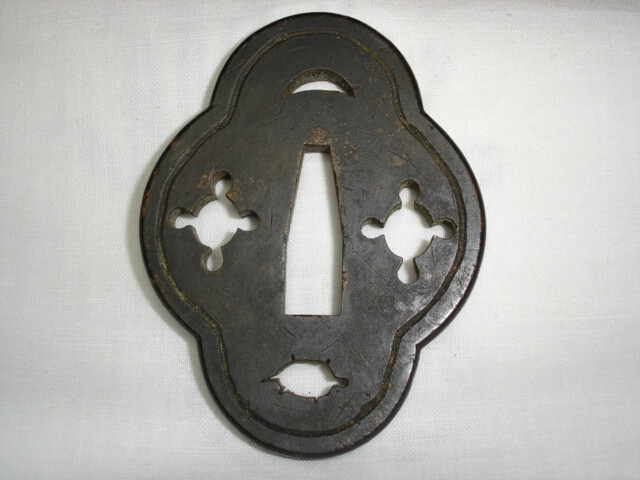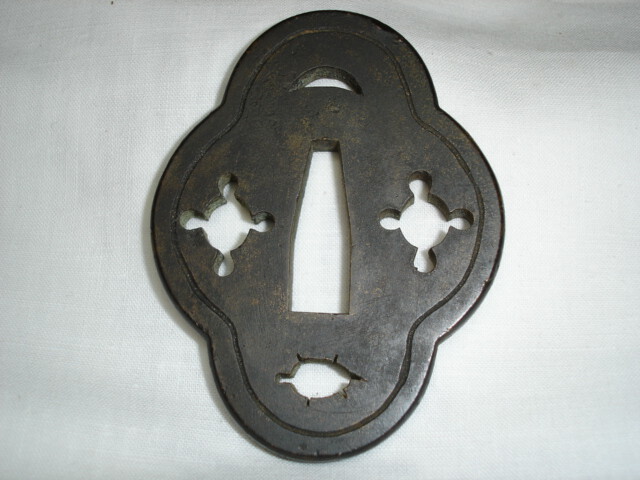-
Posts
14,288 -
Joined
-
Last visited
-
Days Won
276
Content Type
Profiles
Forums
Events
Store
Downloads
Gallery
Everything posted by Bugyotsuji
-
Mmmm.... very nice!
-

New Sword Association in town
Bugyotsuji replied to Ford Hallam's topic in General Nihonto Related Discussion
Thanks for the update. The Japanese site seems to be nearly ready too, but it's strange the way they've done it. When you click on the titles, nothing seems to happen, but you then need to scroll down each time to see the pages. -
Hmmm... the plot thickens. Illustrations welcome!
-
I wonder if the soft metal, the peculiar openings and the groove around the cicumference are all designed to catch and absorb the momentum of the point of an enemy spear or Naginata/Nagamaki?
-
Some examples on pp 82 & 147 of Ian's "Arms & Armour of the Samurai".
-
Very good question, Ford, and I for one shall be interested in the answer, if anyone can help.
-
Koichi san, I finally went for Nissui, (or maybe your Nichizui is better), because I found that actual name 日随 (in your variant form) in a list of known Tsuba makers. The pronunciation was not listed, but the name was listed according to the Japanese alphabetical order under 'Ni' 二 in the book.
-
Ford, thanks for the clarification. I can't tell what it is. Dark greenish patina overall; it must have lain untouched for a long time. Only tiny little exposed flecks show yellowish or reddish hues. Dents along the mimi suggest the metal must be fairly soft. Dirk, your examples above in copper and shinchu seem to reinforce an impression I am starting to form of overall simplicity in design. Should we be splitting this discussion into Nagamaki and Naginata, or are they treatable in common, I wonder ?
-
Thanks Richard for the feedback. Very interesting to hear your views and to see your tsuba. A turtle? Well, that's what I was thinking, but what else could it be? When you say 'rustic', do you mean like a piece of garden furniture? :lol: Dunno.
-
The other day I found this Tsuba. "Yamagane. It's probably a Nagamaki Tsuba. They are pretty rare," was all the seller could tell me. That is the sum and the limit of my knowledge, other than that Yamagane (?) must be brass of some kind. Oh, it's 7.3 x 5.6 cm, and it's heavy & very thick, about 5mm at the seppa dai. Can anyone flush out the picture here, re motif, material, usage, etc? Have I got the wrong end of the stick? Does anyone have a Nagamaki or Naginata Tsuba in their collection for comparison? Hoping like will attract like!
-
The Mei seems to read I like this tsuba too!
-
Methinks I may have to get that. The more the merrier Thanks Stephen.
-
What book is that, Stephen?
-
Yes and no. To cover the length of the seppa-dai, the width of the leaves has been used. I like it.
-
Wasn't there a thread near here somewhere mentioning Tsuba for Naginata/Nagamaki? Well, I have what was described as a Nagamaki Tsuba, and was going to post it up there, but despite running a search I've completely lost the plot!
-

This Week's Edo Period Corner
Bugyotsuji replied to Bugyotsuji's topic in General Nihonto Related Discussion
Peter, look forward to seeing the pics, and then perhaps someone may be able to help. Had a long chat with a friend in antiques today, Ian, about the lid/tray. He agreed with you and said it is definitely old, and probably a family heirloom; a Hiro-buta, 広蓋 which literally means a 'wide lid'. It shows evidence of relacquering, which suggests someone tried to take good care of it. Apparently it was placed on the floor outside the bathing quarters where garments (kimono) were laid into it; the lip kept all in order. He said you could not make one of these for even 100,000 yen today, and the Mon are partcularly expensive to order and have done, something like 10,000 JPY each. He agreed that, sad but true, no-one in Japan today would want to buy such a thing, and recommended that I take it to the West where it can have a new lease on life. Very interesting background to the Shokaku-tsuki Kabuto. Thanks for that. There is a picture of a modern reproduction in one of the links above. (The chap wants to sell it, but has no idea what to ask for it!) -

This Week's Edo Period Corner
Bugyotsuji replied to Bugyotsuji's topic in General Nihonto Related Discussion
Thanks Ian. Japanese burial mounds, right? The design looks like it might be for warding off arrows. There appear to be traces of some form of pitch/lacquer coating. Under Shokaku-tsuki Kabuto I found a few pages on Google. They are in Japanese but most contain a nice little illustration of what you were saying. http://www.google.co.jp/search?q=%E8%A1 ... rt=10&sa=N -

This Week's Edo Period Corner
Bugyotsuji replied to Bugyotsuji's topic in General Nihonto Related Discussion
It's quite late (2:10 am) so I may leave the pics up a little longer and sleep on them. Lid/tray cost. Stephen is the closest so far and flies in under the line. Ian's comment includes a suggestion of the same thing. Well done. The dealer asked apologetically for 1,000 yen, and I told him I would think about it... as I didn't want to carry it around the market. It was absolutely filthy. When I came back it was still there, and he apologized again for the weight. I showed it to a collector friend later and he said "Who has room for that in their house?" I imagined my wife complaining and had to agree with him. (She hasn't seen it yet.) Poor thing is embarrassingly large. As I mentioned in an earlier post, it is a Kiri Mon, but it's called Saga-kiri Mon, and in Saga in Kyoto there is also the Saga Kiku, with the imperial 16 petals. There was an Emperor Saga, and a Saga Genji among other famous names. It cleaned up wonderfully, but unfortunately it's been pretty battered at some time in its life. Are we rescuing history here? A box lid? Interesting. As to the Shokaku-tsuki hachi, Ian, do you know if the sound Sho- is short or long? I wonder what the kanji are? Need to spend some more time looking it up. The chap who has lent it to me is going to float it in the dealer's auction this weekend, and he wanted to know what we thought of it. I asked if I could borrow it for a few days and ask around. He said fine. He's either playing me, or he really doesn't know. I know that he has links to the Chinese antiques market and to people who make 'fake' antiques, but he also digs up some amazing genuine finds too, so really anything is possible. Thanks for your thoughts, though, Ian. -

This Week's Edo Period Corner
Bugyotsuji replied to Bugyotsuji's topic in General Nihonto Related Discussion
Come on, all you good folks out there! How much did this cost? (Brian is disqualified because he knows my Scottish nature.) -

This Week's Edo Period Corner
Bugyotsuji replied to Bugyotsuji's topic in General Nihonto Related Discussion
And a wee shot of the 'tray'. I had a look 'underneath', Ian, but it looks like the slidy bottom of a lacquer tray... The whole measures 92 cm by 55 cm. (I have placed a fairly large Tsuba, 8.6 cm x 8.4 cm) on the surface for size reference.) Again, will erase most ASAP for bandwidth. After some restoration, this is how it is now looking. See below: -

This Week's Edo Period Corner
Bugyotsuji replied to Bugyotsuji's topic in General Nihonto Related Discussion
Ian, I'm going home in a minute, so I'll get the trusty camera out. I say a tray, because the lips (edges) point upwards and not downwards. Are you suggesting that the 'bottom' might actually be the top, and the Mon might be only on the inside of the 'lid'? (It's a large rectangular thing, BTW)? The helmet has four nail holes in the top, and was displayed when found nailed upside down on a wooden base apparently. Thanks for the feedback, and watch this space! Brian, I am going to put a few pics here, but once the comments are out, I will erase the pics completely or to a bare minimum. (Talking of beer, I just quaffed a can of Kirin beer with 99% Purine cut, plus added 'wine polyphenols'! ) Pics now deleted. See Google pages on next page of this thread for illustrations -

This Week's Edo Period Corner
Bugyotsuji replied to Bugyotsuji's topic in General Nihonto Related Discussion
No piccies, Peter? :D Two interesting things floated by this week. One is a rusted banded and riveted helmet, one end featuring what looks like the iron-bound prow of a ship. No-one here can decide if it is Japanese, Chinese, Viking, or what. The second object is a massive tray, black lacquer on wood. It is covered in two types of Kamon, which appear to be the Imperial Chrysanthemum and a type of Kiri called the Saga-kiri Mon. (Saga, with these Kanji, is an area of Kyoto.) It has been suggested that the tray was once used for carrying meals from the kitchens of a huge house or castle. Can anyone guess how much I paid for this tray at the Ako Antiques Fair yesterday? Photos of either supplied upon request. -
Ooof..............
-
What are you guessing, Edward?
-

This Week's Edo Period Corner
Bugyotsuji replied to Bugyotsuji's topic in General Nihonto Related Discussion
Don't believe you...





